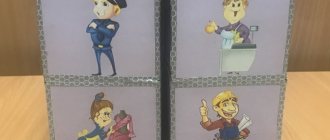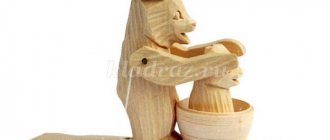Summary of OD in the middle group “Fedoreno Gore”, household work
Joint activity of teachers and children “Fedoreno Gore”, household work in the middle group (4-5 years old)
Author: Gribanova Anna Leonidovna Co-author: Sedelnikova Anna Evgenievna Position and place of work: teachers, MBDOU No. 109 “Kindergarten of a combined type”, Kemerovo. Description of the material: We bring to your attention a summary of the joint activities of the teacher and children in labor education. The material includes the following educational areas: “Cognitive development”, “Social-communicative”, “Speech development”. The notes may be useful for teachers working in the middle group. Goal: to expand children’s understanding of household work. Objectives: 1. Continue teaching how to care for dishes and instill self-care skills. 2. Fix the names of the dishes, types of dishes, material for production. 3. Develop the ability to compare objects, find commonalities, and see the geometric figure at the heart of an object. 4. Improve careful handling of dishes. 5. Cultivate a caring attitude towards dishes. 6. Develop the ability to work with both hands at the same time. 7. Promote team unity, relieve tension, correct shyness. 8. Develop the ability to enter into the image of an object, to show a non-living object with sounds, gestures, and facial expressions. Preliminary work: studying the topics: “Utensils”, “Profession - cook, teacher, junior teacher”, “Household duties”, reading the works of K.I. Chukovsky.
Equipment: a ball for the game, four sheets of geometric figures for the game “What’s What” and pictures of dishes, basins, sponges, aprons, dishes, towels, oilcloths for washing dishes, a cook doll, a teacher, a junior teacher. Progress of educational activities:
The teacher reads excerpts from fairy tales by K.I. Chukovsky, and the children guess which fairy tale the excerpt is from.
Educator: 1. Hey, you animals, come out, defeat the Crocodile, so that the greedy Crocodile will turn the Sun into the sky! Did you find out what work these words are from? Children: “Stolen Sun” 2. He is sitting under a tree. Come to him for treatment. Both the cow and the she-wolf? 3. The bears were riding a bicycle. And behind them the cat is backwards. Now let's blow really hard on the sea out of the confusion? Breathing exercises
Educator: you will listen to the next excerpt in the recording. The teacher plays a recording from the fairy tale “Fedoreno Grief”
: The sieve gallops through the fields, and the trough through the meadows.
The broom followed the shovel along the street. Axes, axes, just pouring down from the mountain, The goat got scared, widened her eyes: “What is it? Why? I won’t understand anything.” And I won't understand anything! Who was running away from whom? Children: Dishes from Fedora. Educator : Of course, you recognized this work? Children: yes, this is the fairy tale “Fedoreno Grief” Educator : which was written... Children: Korney Ivanovich Chukovsky. Next is a conversation about the dishes, about Fedora’s attitude towards them. Educator: 1. Guys, why did all the dishes run away from Fedora? 2. Why wash the dishes? You can buy a lot of pots and that’s it, why cook, eat, and then wash? 3. How did Fedora feel about her dishes? She did everything wrong, the dishes need to be loved and looked after. 4. What kind of dishes are there? (kitchen and dining room) We learn what the dishes are made of during the game. I will name the object, and you will name what it is made of (glass, plate, etc.) Guys, who in our kindergarten uses dishes? (cooks, assistant cook, teachers, children, junior teacher, dolls with toy dishes) The teacher helps the children answer this question with the help of dolls with the words “look who came to visit us?” Then they figure out why each of them needs dishes.
Educator: Now we’ll play.
I have a poster with geometric shapes, and you have cards, you need to choose each card its place. The game “What's what?” is played, after the game Fedora comes in and cries.
Educator: And here is Fedora Egorovna, hello dear, come in. Why are you crying now? Fedora: all the dishes ran away from me. Educator : Guys, what should you do with your dishes so that they don’t run away from you? Children: wash and care for it. Fedora: But of course, I don’t know how. Educator: What should I do with you? Well, first of all, I need to return the dishes. Do you even remember what you had? Fedora : Yes, I have a whole list here, you just need to guess what I have there and show me the answer. - Soup, salad, mashed potatoes, cutlets Always served in... (Plate) - The teapot's friend Has two ears, Cooks porridge, soup for Yulia. And their name is... (Pan) - There will be delicious food With a golden crust, If you use... That's right,... (Frying pan) - They take them out on New Year's Eve, They pour drinks into them for the guests, And, famous for their vocals, They ring when the clock strikes... ( Glasses) - Tell me what to call her: Her teeth are all full of holes, But she grinds beets, radishes, horseradish, carrots deftly. (Grate) - A boat is floating on my plate. I put the boat of food into my mouth. (Spoon) - And for tea and curdled milk, substitute, my friend... (Cup) - On the stove is the boss of the pots. Fat, long-nosed... (Kettle)
Educator: So we guessed and showed all the answers to the riddle. Where can I find your dishes? The teacher draws attention to the Cook doll, who saw where the dishes were hidden. And according to the prompt, counting the steps, he looks for dishes together with the children.
Fedora, together with the children, prepares the work area, distributes sponges, towels, places basins and discusses who will do what (wash, rinse, wipe, take to dry).
The children and the teacher sort the dishes into two groups, kitchen and dining, and begin washing, showing them to Fedora.
After the activity, the teacher praises the children, and together they clean their workplace.
We recommend watching:
Summary of a lesson in the middle group on the works of Marshak Notes of the GCD in the middle group “Help the Cockerel” Summary of the GCD in the middle group on the topic: “Who lives in the little house?” Summary of a design lesson in the middle group "Tumbler"
Similar articles:
Math lesson “Rectangle” in the middle group of kindergarten
Consultation for teachers “Organization of regime moments in preschool educational institutions. Preparation for sleep"
Natalya Dolmatova
Consultation for teachers “Organization of regime moments in preschool educational institutions. Preparation for sleep"
Municipal budgetary preschool educational institution "Kindergarten No. 15" of the city of Aleysk, Altai Territory
Consultation for teachers
Topic: Organization of routine moments in preschool educational institutions “Preparing for sleep and awakening gymnastics”
Completed by: N. V. Dolmatova
Organization of routine moments in the preschool educational institution “Preparing for sleep and awakening gymnastics”
Goal: To develop discipline in preschool children. Creating a calm environment and a positive mood before bed. Develop independence when undressing, accuracy when folding clothes. Cultivate kindness and respect for peers.
The period of preparation for bed should be calm and balanced. Children are not recommended to be distracted by noisy games or emotional conversations. When undressing, the teacher makes sure that the child frees his hair from bows, hairpins, etc.
Daytime sleep is one of the most important factors in the harmonious development of a child and helps to spend the rest of the day in a good mood.
The teacher promotes a calm and relaxing environment in the bedroom and a positive attitude towards daytime sleep. It is necessary to check whether the children are comfortable in their beds, or even better, approach each one, straighten the blanket, pat them on the head and wish them a restful sleep. It is best for a child to sleep on the right side with the body in an arched position. This is a natural, physiologically optimal position. Be sure to observe the child's breathing - it should be nasal. During the ritual of getting ready for bed, a calm melody or lullaby can be played in the group, setting the children up for rest. The teacher can tell them a familiar and beloved fairy tale in a quiet, calm voice. You can sing a lullaby. You should not ask children questions at this time, tell action-packed stories, or call children by name. The child falls asleep - this is a fragile phase of sleep, and it must be protected. Otherwise, the child will be artificially perked up, and then it will be very difficult for him to fall asleep.
The eyelashes droop and the eyes close. We rest peacefully, fall asleep in a magical sleep
Background music is playing, children are lying on rugs and listening to the fairy tale “Cinderella” by Charles Perrault
Carrying out the regime moment “Rising”
Goal: ensuring a smooth transition from sleep to wakefulness, a positive emotional mood, preparation for vigorous activity.
- Good afternoon! Wake up quickly! Smile wider at the sun!
With these words the teacher greets the waking children. Complexes based on a game plot and including elements of improvisation allow one to achieve maximum motor and emotional activity. The teacher accompanies the demonstration of exercises with an explanation. The number of repetitions of each movement depends on the desire and physical condition of the children. The complex is carried out within 5-7 minutes. Children do not wake up from naps all at once. And we try to ensure a smooth gradual recovery of each child from sleep. To do this, the teacher turns on quiet, calm music a few minutes before getting up. Gradually, as the children wake up, the volume of sounds increases. After the children wake up, awakening gymnastics are performed. This is a specially designed set of exercises that allows you to gradually warm up the muscles and lift the mood of children.
I. Introductory part Quiet music is turned on, to which the children gradually wake up, and gymnastics are performed.
We all woke up together, smiled, stretched (Movements corresponding to the text) Breathed deftly (Breathe through the nose) Hummed loudly (oo-oo-oo-oo) Raise your shoulders like grasshoppers in the grass. (Energetic movements of the shoulders up and down). The bear crawled out of the den and looked around at the threshold. (Lying in bed, throw the blanket to the side, turn his head to the right, left) He stretched from sleep Spring has come to us again (Hands up, stretched) To quickly gain strength, He twisted his legs (Movement “bicycle”) The bear scratched behind his ear, ( They imitate the movement of a bear) He wagged his tail slightly, (According to the text) He leaned back and forth, (Bends from a lying position) And with his legs he barely goes beyond the threshold. (Get out of bed) A bear is walking through the forest. This bear is looking for honey. (Walking in place with turning his head to the right, left) He is hungry, sad, Conversing with spring: (They walk out of the bedroom with a bearish step and growl) “Tell me, spring, Where can I get more honey? (Children move to the massage paths (prevention of flat feet): I see stumps, roots, There is no honey, no grass." (They walk, bend over, look in, “looking for honey”) The bear waved his arms, As if dispersing clouds. He drives them back and forth, Well , but he won’t find any honey. (Rotate with straight arms back and forth) He squatted lower, deeper, Found a swarm of bees (Squatted, stood up) But the bee family drove the bear away. Breathing exercises:




